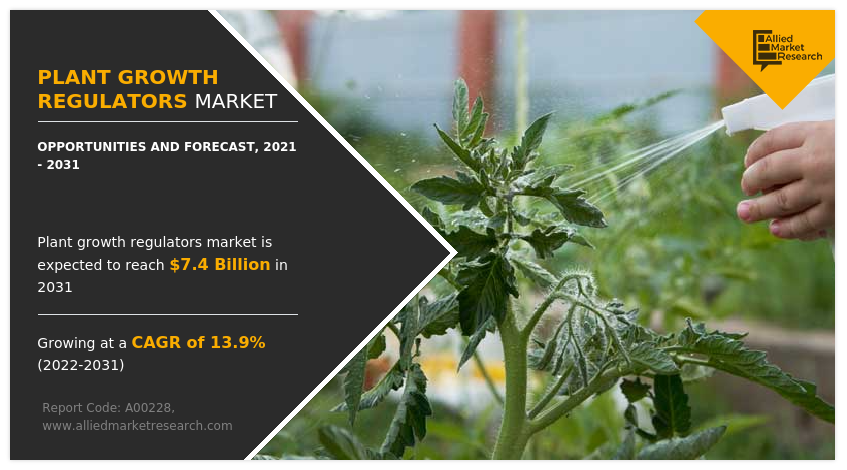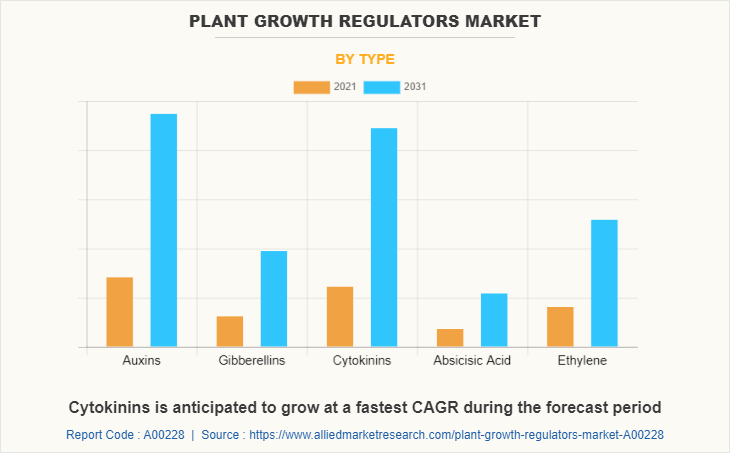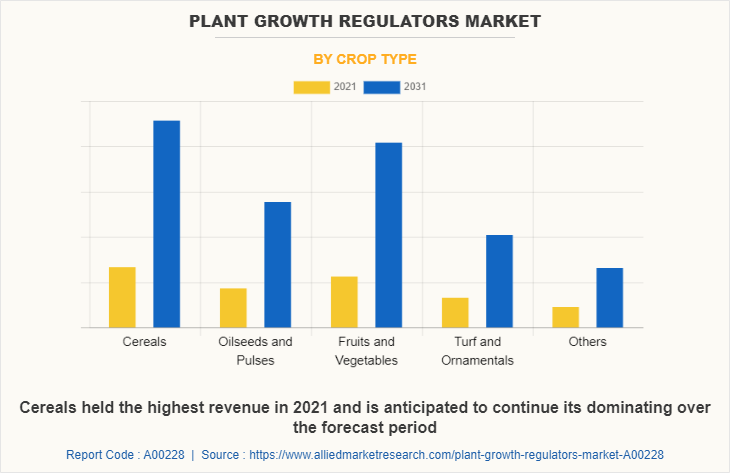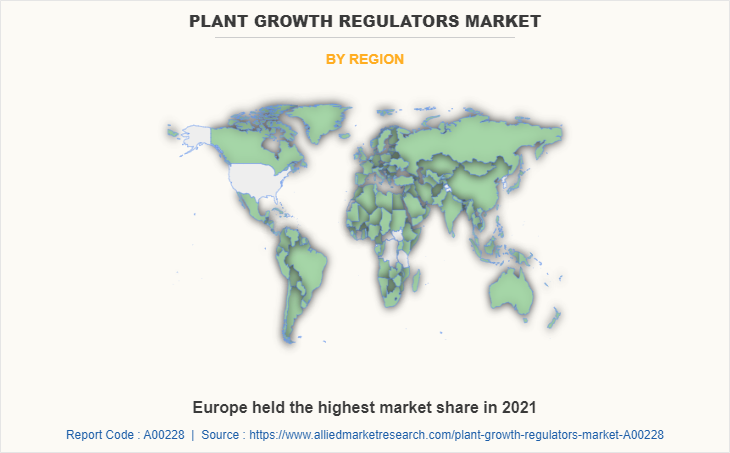Plant Growth Regulators Market Size & Insights:
The global plant growth regulators market size was valued at $2.2 billion in 2021, and is projected to reach $7.4 billion by 2031, growing at a CAGR of 13.9% from 2022 to 2031. Synthetic chemicals called "plant growth regulators" imitate the hormones that plants naturally make. They control or modify a plant's physiological processes to achieve desired effects like improvement in yield and quality. Some common examples include auxins, cytokinins, and gibberellins.
Introduction:
Plant growth regulators in the form of bio-stimulants/bio-inhibitors are in high demand, particularly in agriculture-based economies. Scientific improvements have followed as agriculture has grown more industrialized, assuring the use of innovative inputs to promote crop yield, which has raised demand for plant growth regulators. Additionally, driving the plant growth regulators market include farmers' use of agrochemicals to improve crop protection and supply nutritious product, as well as the rising trend of in-house gardening and farming. These are the major factors anticipated to boost the plant growth regulators market share during the analysis timeframe.

Market Dynamics:
Plant growth regulators are chemical substances that impact plant cell, organ, and tissue development and differentiation. Plant growth regulators can significantly increase crop productivity. It has been shown that a significant percentage of farmers are still unaware of the many types of plant growth regulators available, as well as their accurate and proper technique of application. Furthermore, many farmers are unaware of the cost benefits associated with growth regulators. Lack of awareness regarding benefits of plant growth regulators is expected to restrict the Plant growth regulatorsmarket growth.
Plant growth regulators are chemicals that are used to manage and enhance the natural plant development process. The growing worldwide population, increased consumer desire for organic food, and shrinking agricultural land are the primary factors driving the growth of the plant growth regulator industry. The growing consumer awareness of the importance of maintaining a healthy lifestyle is driving up demand for fruits and vegetables. This, in turn, is expected to drive market expansion throughout the forecast period. Growing demand for medical crops, flowers, and seeds will benefit the horticulture business. This is expected to provide the market with significant plant growth regulators market growth opportunities during the forecast period.
Segment Overview:
The global plant growth regulators market is segmented on the basis of type, crop type, and region. As per type, the market is sub-segmented into auxins, gibberellins, cytokinins, absicisic acid, and ethylene. By crop type, the market is classified into cereals, oilseeds and pulses, fruits and vegetables, turf and ornamentals, and others. Region wise, the market is analyzed across North America, Europe, Asia-Pacific, and LAMEA.
The plant growth regulators market is segmented into Type and Crop Type.

By type, the auxins sub-segment dominated the market in 2021. Auxins are plant growth hormones that regulate cell division and vascular tissue production. They promote root initiation, shoot maturation, and apical dominance (the tendency for the main stem to grow tall without side branches), as well as fruit production. Auxins can be utilized as root stimulators or retarders, cut flower stimulators or retarders, leafing inhibitors or promoters, etc. These are predicted to be the major factors affecting the plant growth regulators market size during the forecast period too.

By crop type, the cereals sub-segment dominated the global plant growth regulators market share in 2021. Plant growth regulators are used in cereal to regulate the crop cycle, avoid lodging of crops, and improve grain size and quality. By delaying the ripening process, they assist to decrease post-harvest losses and allow harvesting intervals to be prolonged. Due to their capacity to boost plant vigor and production, auxins and cytokinins play a significant role in this application, resulting in higher yields of produce of superior quality.

By region, Europe dominated the global market in 2021. High demand for fruits and vegetables in the region, as well as harsh climatic circumstances in many countries, are projected to expand the use of plant growth regulators to boost agricultural productivity. Europe is one of the most key markets for plant growth regulators, owing to rising demand from nations such as Germany, the United Kingdom, France, and Italy, among others. This may be attributable to the region's expanding population, which is predicted to boost the regional market during the plant growth regulators market forecast years.
Competitive Analysis:
The key players profiled in this report include BASF SE, Bayer Crop Science, Corteva Agriscience, Crop Care Australasia Pty Ltd., Barclay Crop Protection, Sumitomo Chemical Australia Pty Ltd., NuFarm Ltd., Redox Industries Ltd., Xinyi (H.K.) Industrial Co. Ltd., and Sichuan Guoguang Agrochemical Co. Ltd.
Key Benefits For Stakeholders
- This report provides a quantitative analysis of the market segments, current trends, estimations, and dynamics of the plant growth regulators market analysis from 2021 to 2031 to identify the prevailing plant growth regulators market opportunities.
- The market research is offered along with information related to key drivers, restraints, and opportunities.
- Porter's five forces analysis highlights the potency of buyers and suppliers to enable stakeholders make profit-oriented business decisions and strengthen their supplier-buyer network.
- In-depth analysis of the plant growth regulators market segmentation assists to determine the prevailing market opportunities.
- Major countries in each region are mapped according to their revenue contribution to the global plant growth regulators market.
- Market player positioning facilitates benchmarking and provides a clear understanding of the present position of the market players.
- The report includes the analysis of the regional as well as global plant growth regulators market trends, key players, market segments, application areas, and market growth strategies.
Plant Growth Regulators Market Report Highlights
| Aspects | Details |
| Market Size By 2031 | USD 7.4 billion |
| Growth Rate | CAGR of 13.9% |
| Forecast period | 2021 - 2031 |
| Report Pages | 280 |
| By Type |
|
| By Crop Type |
|
| By Region |
|
| Key Market Players | Syngenta AG, Arysta Life science, Nufarm, FMC Corporation, TATA chemicals limited, Bayer Crop Science AG, UPL Limited, BASF SE, Corteva Agriscience, Sumitomo Chemical Australia |
Analyst Review
The growth in demand for organic food across the globe, which has led to an increase in the organic food industry, is accountable for the expansion of the global market for plant growth regulators. The increasing number of food and beverage projects throughout the world is also increasing the demand for more production, which may be satisfied by using plant growth regulators. However, a significant percentage of farmers are still unaware of the plant growth regulators and their precise and acceptable use for various applications, which restricts the plant growth regulators market. Plant growth regulators are in high demand because of their ability to prevent lodging in intensive grain production, regulate shoot heights, and increase latex flow in rubber plants. These factors boost plant development and accelerate output as compared to conventional fertilizers and are anticipated to provide remunerative opportunities for key players to maintain the pace of the plant growth regulators market in the upcoming years.
Among the analyzed regions, Europe is expected to account for the highest revenue in the market by the end of 2031, followed by Asia-Pacific, North America, and LAMEA. Rise in demand for organic food product and growth in the organic food industry are the key factors responsible for leading position of Europe and Asia-Pacific in the global plant growth regulators market.
The major growth strategies adopted by plant growth regulators market players are investment and agreement.
The rising demand for organic foods all over the world, which has resulted in the expansion of the organic food industry, is a significant factor driving the development of the plant growth regulator market. In addition, an increase in textile production and the adoption of organic farming are also projected to provide growth opportunity for the worldwide plant growth regulators market during the forecast period.
Agriculture industry leaders and chemicals manufacturers are the major customers in the global plant growth regulators market.
Cereals sub segment acquired the maximum share of the global plant growth regulators market in 2021.
The growing need for agricultural production enhancement, along with expanding global demand, is propelling the plant growth facilities which is anticipated to boost the plant growth regulators market in the upcoming years.
Asia-Pacific will provide more business opportunities for the global plant growth regulators market in future.
BASF SE, Bayer Crop Science, Corteva Agriscience, Crop Care Australasia Pty Ltd., Barclay Crop Protection, Sumitomo Chemical Australia Pty Ltd., NuFarm Ltd., Redox Industries Ltd., Xinyi (H.K.) Industrial Co. Ltd., Sichuan Guoguang Agrochemical Co. Ltd. are the major players in the plant growth regulators market.
The report provides an extensive qualitative and quantitative analysis of the current trends and future estimations of the global plant growth regulators market from 2021 to 2031 to determine the prevailing opportunities.
Loading Table Of Content...



